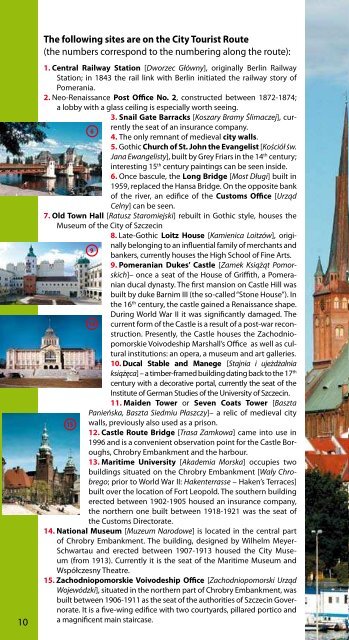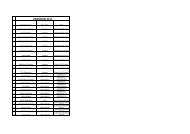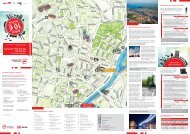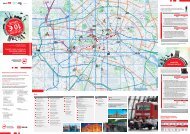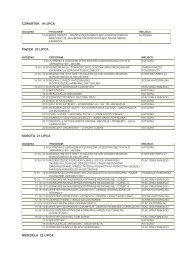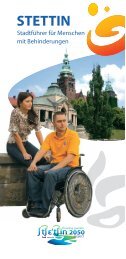Sightseeing Around Szczecin
Sightseeing Around Szczecin
Sightseeing Around Szczecin
You also want an ePaper? Increase the reach of your titles
YUMPU automatically turns print PDFs into web optimized ePapers that Google loves.
10<br />
The following sites are on the City Tourist Route<br />
(the numbers correspond to the numbering along the route):<br />
1. Central Railway Station [Dworzec Główny], originally berlin Railway<br />
Station; in 1843 the rail link with berlin initiated the railway story of<br />
Pomerania.<br />
2. neo-Renaissance Post Office No. 2, constructed between 1872-1874;<br />
a lobby with a glass ceiling is especially worth seeing.<br />
3. Snail Gate Barracks [Koszary Bramy Ślimaczej], cur-<br />
rently the seat of an insurance company.<br />
4. The only remnant of medieval city walls.<br />
5. Gothic Church of St. John the Evangelist [Kościół św.<br />
Jana Ewangelisty], built by Grey friars in the 14 th century;<br />
interesting 15 th century paintings can be seen inside.<br />
6. once bascule, the Long Bridge [Most Długi] built in<br />
1959, replaced the Hansa bridge. on the opposite bank<br />
of the river, an edifice of the Customs Office [Urząd<br />
Celny] can be seen.<br />
7. Old Town Hall [Ratusz Staromiejski] rebuilt in Gothic style, houses the<br />
Museum of the city of <strong>Szczecin</strong><br />
8. late-Gothic Loitz House [Kamienica Loitzów], origi-<br />
15<br />
6<br />
9<br />
14<br />
nally belonging to an influential family of merchants and<br />
bankers, currently houses the High School of fine arts.<br />
9. Pomeranian Dukes’ Castle [Zamek Książąt Pomorskich]–<br />
once a seat of the House of Griffith, a Pomeranian<br />
ducal dynasty. The first mansion on castle Hill was<br />
built by duke barnim iii (the so-called “Stone House”). in<br />
the 16 th century, the castle gained a Renaissance shape.<br />
during World War ii it was significantly damaged. The<br />
current form of the castle is a result of a post-war reconstruction.<br />
Presently, the castle houses the zachodniopomorskie<br />
Voivodeship Marshall’s office as well as cultural<br />
institutions: an opera, a museum and art galleries.<br />
10. Ducal Stable and Manege [Stajnia i ujeżdżalnia<br />
książęca] – a timber-framed building dating back to the 17 th<br />
century with a decorative portal, currently the seat of the<br />
institute of German Studies of the university of <strong>Szczecin</strong>.<br />
11. Maiden Tower or Seven Coats Tower [Baszta<br />
Panieńska, Baszta Siedmiu Płaszczy]– a relic of medieval city<br />
walls, previously also used as a prison.<br />
12. Castle Route Bridge [Trasa Zamkowa] came into use in<br />
1996 and is a convenient observation point for the castle boroughs,<br />
chrobry embankment and the harbour.<br />
13. Maritime University [Akademia Morska] occupies two<br />
buildings situated on the chrobry embankment [Wały Chrobrego;<br />
prior to World War ii: Hakenterrasse – Haken’s Terraces]<br />
built over the location of fort leopold. The southern building<br />
erected between 1902-1905 housed an insurance company,<br />
the northern one built between 1918-1921 was the seat of<br />
the customs directorate.<br />
14. National Museum [Muzeum Narodowe] is located in the central part<br />
of chrobry embankment. The building, designed by Wilhelm Meyer-<br />
Schwartau and erected between 1907-1913 housed the city Museum<br />
(from 1913). currently it is the seat of the Maritime Museum and<br />
Współczesny Theatre.<br />
15. Zachodniopomorskie Voivodeship Office [Zachodniopomorski Urząd<br />
Wojewódzki], situated in the northern part of chrobry embankment, was<br />
built between 1906-1911 as the seat of the authorities of <strong>Szczecin</strong> Governorate.<br />
it is a five-wing edifice with two courtyards, pillared portico and<br />
a magnificent main staircase.<br />
24<br />
16. Monument of Adam Mickiewicz, unveiled in 1960.<br />
before World War ii the location was occupied by<br />
a monument of the German emperor frederick iii.<br />
17. PAZIM Complex, used since 1992, houses offices<br />
(including shipping companies), banks, service<br />
shops, “Radisson” Hotel and – on the 22 nd floor –<br />
a café and an observation deck.<br />
18. baroque Royal Gate [Brama Królewska] was built<br />
between 1725-1727 as part of <strong>Szczecin</strong>’s fortifications.<br />
19. Church of St. Peter and St. Paul [Kościół śś. Piotra i Pawła] was built in<br />
the mid 15 th century, replacing an earlier wooden construction; its walls<br />
are decorated with terracotta sculptures of <strong>Szczecin</strong> townspeople, in<br />
the interior there is a wooden ceiling dating back to the early 18 th century<br />
covered with paintings depicting biblical scenes.<br />
20. Mast of S/S “Kapitan Maciejewicz” is situated<br />
over the location of the city Theatre, demolished<br />
after World War ii.<br />
21. Professors’ Houses [Domki profesorskie] were inhabited<br />
by lecturers of St. Mary’s college.<br />
22. St. Mary’s School erected between 1830-1832,<br />
currently houses a high school.<br />
23. Birthplace of Empress Catherine II of Russia – in<br />
1729, Sophie friederike auguste zu anhalt-zerbst,<br />
later the wife to Russian emperor Peter iii, known as<br />
catherine the Great, was born here. currently the<br />
building belongs to an insurance company.<br />
24. Archcathedral Basilica of St. James [Bazylika Ar-<br />
chikatedralna św. Jakuba] – repeatedly remodelled sanctuary founded in<br />
1187. Seriously damaged in 1944, rebuilt in a Gothic form in the 1970s,<br />
houses a diocesan museum. a bell cast in 1682, parochial buildings together<br />
with a Gothic vicar house dating back to the 15 th century can be<br />
found in front of the church. in 2008, a new spire was built;<br />
inside the tower is an observation desk available for visitors.<br />
25. baroque Flora Statue sculpted in the 18 th century depicts<br />
a Roman goddess of Spring and yield; originally, it adorned<br />
a garden of one of the nearby palaces.<br />
26. baroque Fountain with an Eagle made in 1732.<br />
27. Palace under the Globe [Pałac Pod Globusem] was built in<br />
the late 19 th century, replacing the Grumbkow’s Palace dating<br />
back to the first half of the 18 th century. in 1759, Sophie<br />
dorothea of Württemberg, later wife to the Russian emperor<br />
Paul i, known as Maria feodorovna, was born here.<br />
28. Velthusen’s Palace, also known as Classicistic Palace<br />
[Pałac Velthusena, Pałac Klasycystyczny] built between 1778-<br />
1779, currently houses a music school.<br />
29. Diets’ Palace [Pałac Sejmu Stanów Pomorskich] was erected between<br />
1726-1728. currently it belongs to the National Museum.<br />
30. Contemporary Art Gallery and 13 Muses’ Club [Galeria Sztuki<br />
Współczesnej, Klub XIII Muz].<br />
31. Plaque commemorating the foundation of Polish<br />
scouting in <strong>Szczecin</strong>.<br />
32. neo-baroque former seat of the Pomeranian<br />
Landowners’ Bank (currently: the seat of PKo bP<br />
bank) built between 1893-1895.<br />
33. Former seat of the Prussian Royal Post (currently:<br />
Polish Post) was erected between 1901-1905.<br />
34. neo-Gothic Church of St. John the Baptist [Kościół<br />
św. Jana Chrzciciela], built in 1890 for the catholic community. inside<br />
the church a plaque commemorating the German catholic priests murdered<br />
by the nazis can be found.<br />
30<br />
19<br />
33<br />
40<br />
11


